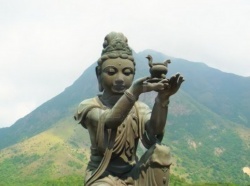Magga-phala
The Characteristics of Forgetting - (Cessation) Due to Magga-phala
1) The meditator has practised gradually from the 3rd ñāna up to the 11th ñāna according to the stages of ñāna as mentioned before. The meditator who practises beginning from udayabbaya-ñāna up to sankhārupekkhā-ñāna may forget as well. However, we must not decide that magga-phala has happened. We should practice further.
2) When the practice has been done and strange things happen in vutthāna-gāminī vipassanā, or whether one has already regained sankhārupekkhā-ñāna or not but almost reached it, one may forget likewise. But the meditator must not decide that it is forgetting because of magga-phala.
3) There is cessation repeatedly, reaching cessation calmly again and again, after paccavekkhana coming back to udayabbaya-ñāna ascending again and ceasing again. This is entering phala-samā patti (absorption in fruit-consciousness).
4) Having practised one enters the domain of vutthāna-gāminī with much speed, then sudden cessation and paccavekkhana happen, after which it starts again from udayabbaya-ñāna, ascending anew and reaching cessation again to enter phala-samā patti and paccavekkhana follows. Then we may be sure.
5) When determining for quick cessation it happens as willed. In this way one can examine the strength of appanā-samādhi so as to enter phala-samā patti quicker, as desired, even after only 5 minutes it can arise.
6) One wants to determine for it to last long, that means: Determine for phala-samā patti to last 5 minutes, 10 minutes, 30 minutes, 1 hour, 2-3-4-5-6-7-8-9-10-11-12 hours, and it happens as determined.
7) In making up one's mind as to the characteristics of the cessation in the magga, the meditator must not give rise to desire or want to attain quickly, because then it will be the false magga in most cases. When Cessation has happened, he will decide for himself that he has attained magga-phala and that he must not cling too much. Because that cessation is very delicate. Some people have very strong samādhi and experience cessation, but it is not cessation in magga; mostly it is cessation in samādhi. If we think it is magga, this is a wrong conclusion.
8) The meditator must have no anticipation as to when the magga-phala will arise. Anticipation is attā (self-delusion), it is craving; so, if magga arises, it will be false magga.
9) By practising successively with diligence throughout, from sammasana-ñāna (3rd ñāna) according to the stages, the 5 indriya (saddhā, viriya, sati, samādhi, paññā) get evenly balanced and gradually increase power until entering vutthāna-gāminī vipassanā and reaching Cessation together with paccavekkhana, coming back to udayabbaya-ñāna, ascending and ceasing again and phala-samā patti arises. When determining to reach cessation quickly, it will happen as desired; or determining that phala-samā patti may last long and it happens as determined: In this way the meditator will definitely have certainty and confidence in himself that Cessation due to magga already happened.

